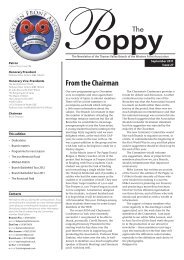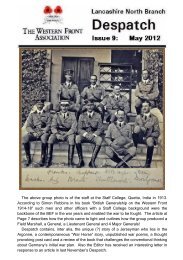The_Poppy_March_2012.pdf - The Western Front Association
The_Poppy_March_2012.pdf - The Western Front Association
The_Poppy_March_2012.pdf - The Western Front Association
Create successful ePaper yourself
Turn your PDF publications into a flip-book with our unique Google optimized e-Paper software.
Millicent Duchess of Sutherland Ambulance<br />
by Bridgeen Fox<br />
Millicent, Duchess of Sutherland, was born in Fife on 20th<br />
October 1867 and married Cromartie-Leveson Gower in<br />
1884, when she was just seventeen. In 1892 she became the<br />
Duchess of Sutherland. She was a society beauty, a successful<br />
London hostess, whose portrait was painted in Stafford<br />
House by John Singer Sargent. She was an omnivorous<br />
reader, wrote fiction which included a book entitled ‘ Seven<br />
Love Stories,’ published by Heineman in 1902 and her war<br />
memoir, ‘Six weeks at the War,’ published in 1915 by A.C.<br />
McClurg , 1915.<br />
She was a serious activist for social reform and one of her<br />
projects was to form a technical school in Golspie, Scotland,<br />
but she will probably be best remembered for establishing,<br />
in 1896, the North Staffordshire Cripples’ Aid Society, a<br />
charity with the aim of training a number of crippled boys<br />
in North Staffordshire and teaching them a trade, ‘generally<br />
assisting them to obtain a living when, by reason of their<br />
misfortunes, they are disqualified from doing so through the<br />
usual channels.’ In 1902 the Guild began to do practical silver<br />
smithing and was soon producing handicrafts of a very high<br />
standard in the Arts & Crafts Movement.<br />
Her Involvement in philanthropic schemes at home was<br />
interrupted when war was declared on 4th August 1914.<br />
Millicent had persuaded the French Minister of War to<br />
exempt her from those regulations forbidding foreigners<br />
from serving in French hospitals. She had also enlisted the<br />
Portrait of Millicent, Duchess of Sutherland<br />
1904 by John Singer Sargent<br />
help of Winston Churchill in overcoming entrenched Royal<br />
Army Medical Corps opposition to her plans.<br />
At the time British organisations, individuals and groups<br />
of friends, gave lavishly of funds, stores and the services of<br />
trained nurses to the French, Belgian and Serbian Allies and,<br />
by 17th August 1914, Millicent had installed an ambulance<br />
with eight trained nurses and a surgeon, Mr Oswald Morgan<br />
of Guys’ Hospital, in Namur. This became the No.9 Red Cross<br />
Hospital (Millicent Duchess of Sutherland’s Ambulance)<br />
and it was established in the Convent of Les Soeurs de Notre<br />
Dame. On 22nd August 1914 German forces attacked Namur<br />
and the hospital was inundated with wounded soldiers. In her<br />
book ‘Six Weeks at the War,’ which is really a diary, she gives<br />
a graphic account of her experiences on that day:<br />
45 soldiers were brought wounded mostly by shrapnel but<br />
a few were bullet wounds which inflict terrible gashes but<br />
if taken in time rarely prove mortal. <strong>The</strong> wounded were<br />
all Belgian – Flemish and Walloon or French, many were<br />
Reservists. Our young surgeon, Mr. Morgan, was perfectly<br />
calm and so were our nurses. What I thought would be for<br />
me an impossible task became perfectly natural: to wash<br />
wounds, to drag off rags and clothing soaked in blood, to<br />
soothe a soldier’s groans, to raise a wounded man while he<br />
was receiving Extreme Unction, hemmed in by nurse and a<br />
priest, so near he seemed to death; these actions seemed<br />
7



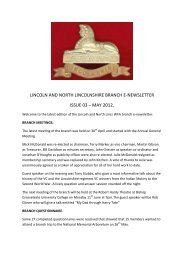
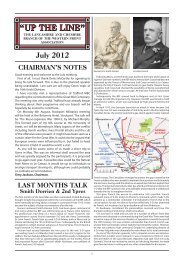

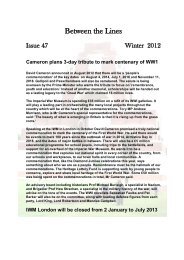

![Fromelles Australian Working List[1].pdf - The Western Front ...](https://img.yumpu.com/29972632/1/184x260/fromelles-australian-working-list1pdf-the-western-front-.jpg?quality=85)
